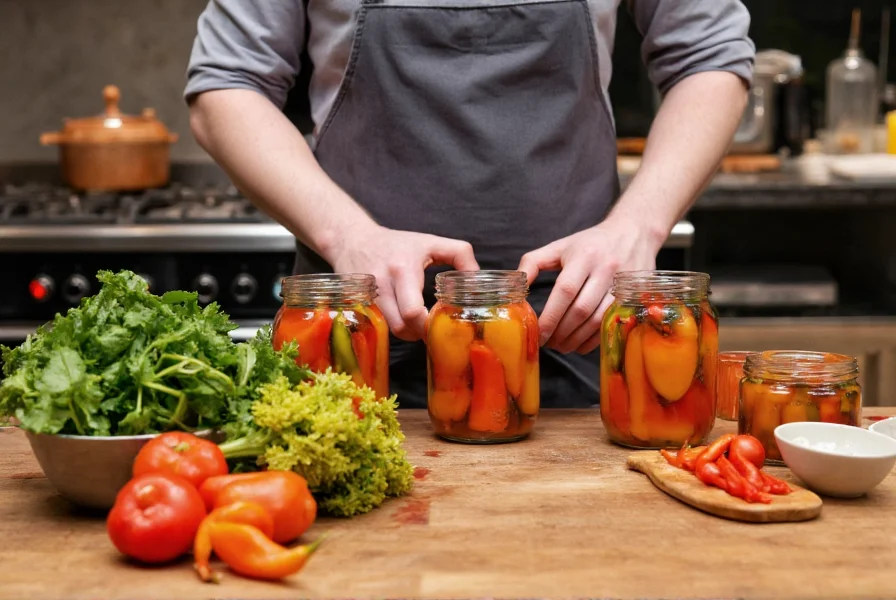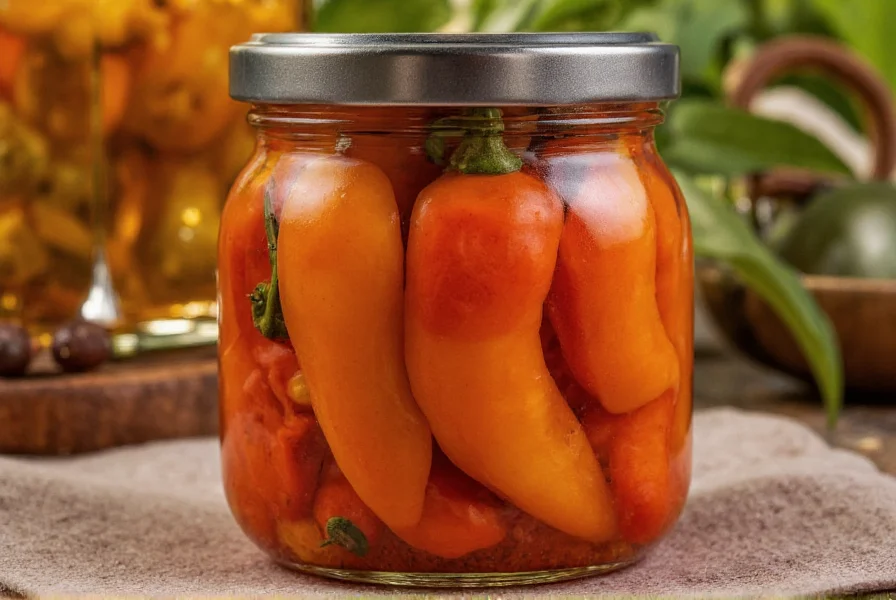Pickled peppers are fresh peppers preserved in a vinegar-based brine solution, often with added spices like garlic, oregano, and peppercorns. This preservation method creates a tangy, flavorful condiment that enhances sandwiches, salads, pizzas, and many ethnic dishes while extending the peppers' shelf life significantly.
Understanding the pickled pepper begins with recognizing its role as both a preservation technique and flavor enhancer in global cuisines. Unlike fresh peppers that spoil within weeks, properly pickled varieties maintain their crisp texture and vibrant flavor for months when stored correctly. The pickling process involves submerging peppers in an acidic solution that prevents bacterial growth while infusing them with complex flavors from accompanying spices.
Common Pepper Varieties for Pickling
Not all peppers respond equally well to pickling. Certain varieties maintain their structure and develop superior flavor profiles when preserved:
| Pepper Type | Heat Level (SHU) | Pickling Characteristics |
|---|---|---|
| Jalapeño | 2,500-8,000 | Retains firm texture; develops complex flavor with garlic and cumin |
| Serrano | 10,000-23,000 | Intensifies heat slightly; excellent with oregano and bay leaves |
| Fresno | 2,500-10,000 | Develops sweet-tangy profile; works well with sugar in brine |
| Pepperoncini | 100-500 | Naturally mild; absorbs flavors beautifully; ideal for beginners |
| Hungarian Wax | 1,000-15,000 | Heat increases with age; transforms from mild to medium-hot |
When selecting peppers for pickling, choose specimens that are firm, unblemished, and at their peak ripeness. Green peppers generally yield a brighter, more vegetal flavor, while red or yellow varieties contribute natural sweetness to the final product. The best pickled peppers for sandwiches typically come from milder varieties like pepperoncini or banana peppers, which provide flavor without overwhelming heat.
The Science Behind Successful Pepper Pickling
Effective pickling requires understanding the chemical processes that preserve peppers while enhancing their flavor. The standard brine solution consists of vinegar (minimum 5% acidity), water, salt, and sugar in specific ratios that create an environment inhospitable to harmful bacteria while allowing beneficial flavor development.
A typical professional-grade brine uses a 1:1 ratio of vinegar to water with 1 tablespoon of pickling salt per cup of liquid. The addition of calcium chloride (food-grade) at 0.1% concentration helps maintain crispness by strengthening pectin bonds in the pepper cell walls—a technique used by commercial producers of pickled peppers to prevent softening during shelf storage.
The pickling timeline varies significantly based on pepper thickness and desired flavor intensity. Thin-walled peppers like serranos may reach optimal flavor in 2-3 weeks, while thick-walled jalapeños often require 4-6 weeks for complete flavor penetration. Temperature also affects the process—ideal pickling occurs between 70-75°F (21-24°C), with cooler temperatures slowing flavor development.
Culinary Applications of Pickled Peppers
Understanding how to incorporate the best pickled peppers in recipes elevates everyday cooking. Professional chefs utilize these preserved peppers in three primary ways:
- As a condiment - Sliced rings add brightness to burgers, tacos, and sandwiches
- As an ingredient - Finely chopped peppers blend into sauces, dressings, and marinades
- As a flavor base - The brine itself seasons beans, grains, and roasted vegetables
For authentic Mexican cuisine, pickled jalapeños with carrots (known as "jardineria") provide the characteristic tang in street tacos. Italian cooking frequently features pickled pepperoncini alongside olives and cheeses. In Southern cooking, pickled banana peppers often accompany fried foods as a palate-cleansing element.
When substituting fresh peppers with pickled versions in recipes, reduce additional salt by 25% and vinegar by 50% to account for the brine's existing seasoning. The health benefits of consuming pickled peppers include preserved vitamin C content (though reduced from fresh peppers) and the probiotic benefits of fermented varieties, though most commercial pickled peppers use vinegar rather than fermentation.
Storage Guidelines and Safety Considerations
Proper storage ensures both safety and quality of homemade pickled peppers. After the initial pickling period, store jars in a cool, dark place for up to 12 months. Once opened, refrigerate and consume within 2-3 months. Always use clean utensils when handling to prevent contamination.
Watch for these signs of spoilage in homemade pickled peppers storage:
- Cloudy brine (unless containing garlic, which naturally clouds brine)
- Bulging lids or leaking seals
- Mold growth on surface
- Foul or alcoholic odor
- Soft, mushy texture
Commercially produced pickled peppers typically contain preservatives that extend shelf life to 2-3 years unopened. Always check expiration dates and avoid products with compromised seals. The shelf life of opened pickled peppers in the refrigerator rarely exceeds 3 months regardless of preservation method due to gradual flavor degradation and potential bacterial growth.

Creating Restaurant-Quality Pickled Peppers at Home
Professional results require attention to detail in every step of the process. Start with a sterilized glass jar (boiled for 10 minutes) and select peppers of uniform size for consistent pickling. Leave ½ inch headspace at the top of the jar to allow for proper sealing.
The spice blend makes the difference between ordinary and exceptional pickled peppers. A chef-recommended combination includes:
- 2-3 garlic cloves per pint jar
- 1 teaspoon whole black peppercorns
- ½ teaspoon red pepper flakes (optional)
- 1 dried bay leaf
- ¼ teaspoon coriander seeds
- 1 sprig fresh oregano or ½ teaspoon dried
For the perfect pickled peppers brine recipe, combine 1 cup distilled white vinegar (5% acidity), 1 cup water, 1½ tablespoons pickling salt, and 1 tablespoon sugar in a non-reactive pot. Bring to a rolling boil, then pour over prepared peppers in the jar, leaving proper headspace. Seal with sterilized lid and ring, then process in a boiling water bath for 10 minutes for proper preservation.
Frequently Asked Questions
Can you eat pickled peppers directly from the jar?
Yes, properly prepared pickled peppers are safe to eat directly from the jar. Commercial products undergo pasteurization, while correctly processed homemade versions maintain safety through proper acidity levels. Always check for signs of spoilage like mold, off-odors, or bulging lids before consumption.
Why do my homemade pickled peppers become soft?
Softening typically occurs due to insufficient acidity in the brine, improper processing time, or using non-pickling salt that contains anti-caking agents. Adding ¼ teaspoon of food-grade calcium chloride per pint or using pickling crisp products can help maintain texture. Overcooking during the pickling process also causes softening.
Do pickled peppers retain nutritional value?
Pickled peppers retain significant vitamin C and capsaicin content, though some water-soluble vitamins leach into the brine. The pickling process preserves approximately 60-70% of the original vitamin C content found in fresh peppers. The vinegar base may enhance mineral absorption, while the capsaicin responsible for heat remains stable during preservation.
How can I reduce the heat level of pickled jalapeños?
To reduce heat in pickled jalapeños, remove seeds and white membranes before pickling, as these contain most capsaicin. Soaking sliced peppers in cold water for 30 minutes before processing draws out some heat compounds. Adding 1-2 tablespoons of sugar to the brine also counterbalances perceived heat. For significant reduction, choose jalapeños with fewer striations, which indicate lower capsaicin levels.
Can I reuse pickled pepper brine for other foods?
Yes, pickled pepper brine makes an excellent marinade base or salad dressing ingredient. Strain the brine to remove spices, then use within 2 weeks for best quality. It works particularly well for pickling additional vegetables like onions, carrots, or cauliflower. Avoid reusing brine that has been contaminated with food particles to prevent spoilage.











 浙公网安备
33010002000092号
浙公网安备
33010002000092号 浙B2-20120091-4
浙B2-20120091-4